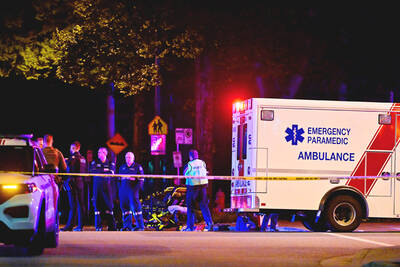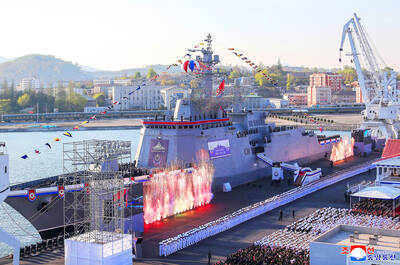For more than three decades, Cambodian villages have been home to silent killers: Former Khmer Rouge commanders who slit the throats of hundreds, sometimes thousands, of victims before dumping their bodies into shallow graves.
Filmmaker Thet Sambath spent 10 years combing the countryside trying to find those who carried out massacres so they — together with the genocidal regime’s ideological leader, Nuon Chea — could reveal the truth about one of the 20th century’s darkest chapters.
Their stories are told in the groundbreaking documentary Enemies of the People, which is playing in limited release in the US, with more theaters to be added each week into the fall, its distributor says.
At least 1.7 million people — a quarter of the population — died from execution, disease, starvation and overwork when the ultra-communist Khmer Rouge tried to turn the country into a vast, agrarian paradise from 1975 to 1979.
In the film, Soun, a former militia commander, sits beneath a tree and gazes out at what are now sparkling green rice paddies.
“I come back here to where I killed people,” he says wearily, pointing to a half dozen spots where swollen bodies used to pile up.
“I feel terrible ... My soul, my body is spinning inside. All the things I did are flashing through my mind,” Soun said.
He recalls smelling blood on his hands as he was eating rice one night: Earlier, he was looking into the eyes of a beautiful tailor who was clinging to his knees, begging to be spared. Tempted, he asked if she would live with him forever.
She quickly promised, but when he heard his own boss yell, “What are you waiting for! Hurry up!,” he thrust his knife into her and threw her on the stack.
Soun leads the 42-year-old Thet to confront other killers, who have to be convinced, slowly, to confess, and then to those who issued orders to kill ethnic minorities and others suspected of being traitors or spies for Vietnam.
Eventually it becomes clear, as they go up the chain of command, that there was probably never an “original order” from the Khmer Rouge’s inner clique to carry out massacres in the countryside.
Rather, regional chiefs, and officials directly above them were interpreting what they were hearing at an abstract political level.
The genocide occurred during the troubled times of the Cold War.
The Khmer Rouge faced internal struggles from the start. The two top leaders, Pol Pot, who died in 1998, and Nuon Chea, awaiting trial before a UN-backed war crimes tribunal, supported China. But many others were looking to their powerful neighbor to the east, Vietnam.
Nuon Chea confesses for the first time in the film that he and Pol Pot together decided to kill all party members considered “enemies of the people.” They had to be destroyed, he said defiantly, to “save the party” and “keep the rot from spreading.”
But he said he was unaware — or too busy to care — what was happening in villages and the rice fields.
The journey was a highly personal one for Thet, a senior reporter at the Phnom Penh Post newspaper.
When he was a boy, his father was stabbed to death after a public meeting organized by a Khmer Rouge cadre, where he objected to plans to seize livestock, gold and other personal property for the party.
His mother was forced to marry a member of the Khmer Rouge militia soon after, got pregnant and died in childbirth. His brother was also killed.
Thet thought that finding people who took part in some of the massacres would help him understand and heal. In the end, those who opened up to him, revealing atrocities they have kept secret from even their wives and children, also seemed to benefit.
“I want to reveal to you all the killers I know,” said Soun, who also talks at one point about drinking the bitter bile from victims’ gall bladders to gain strength.
“When we find them, and they confess the truth, I feel better,” Thet days. “I want this documentary to be shown all over the country, in the provinces, in the cities. Then the people who were killers in the regime will come forward and say, ‘Ya, I used to do that, too.’”
“Otherwise we will be gone soon, and the new generation won’t know the story,” Thet added.
In one of the most chilling scenes, Thet asks Soun to demonstrate how he killed people. A man lies on his stomach as the former militia commander, at first embarrassed, steps on his back and pulls up his head up. He takes a plastic knife and draws it across his victim’s throat.
“You hold them like this so that they cannot scream,” Soun says, slowly gaining confidence. “Sometimes I did it another way, because after I slit so many throats like this my hand ached, so I switched to stabbing the neck.”
It took years for Thet to win Nuon Chea’s full trust.
By the end, the two have formed an unquestionable bond. The war crimes court reviewing Nuon Chea’s case has asked for a copy of the film — coproduced by Thet and Briton Rob Lemkin — but he refused, saying he feels it would be a betrayal of trust.
Thet brings Soun and another man who has admitted to ordering countless killings to visit Nuon Chea so they can ask him directly why so many people had to die at their hands. They ask, too, if they themselves might end up in court.
“They are not after people like you,” Nuon Chea says in a grandfatherly manner, adding that they should not feel bad about what they did. After all, they were trying to help save the nation.
“You were the fighters, and you should be proud,” he says, adding that according to Buddhist teachings, their intentions were honorable, so they need not fear punishment now, or in their next lives.
But the tormented Soun is not convinced.
“I don’t know what I’ll be reborn as in the next life,” he says. “How many holes must I go through before I can be reborn as a human being again. I feel desperate, but I don’t know what to do.”

Archeologists in Peru on Thursday said they found the 5,000-year-old remains of a noblewoman at the sacred city of Caral, revealing the important role played by women in the oldest center of civilization in the Americas. “What has been discovered corresponds to a woman who apparently had elevated status, an elite woman,” archeologist David Palomino said. The mummy was found in Aspero, a sacred site within the city of Caral that was a garbage dump for more than 30 years until becoming an archeological site in the 1990s. Palomino said the carefully preserved remains, dating to 3,000BC, contained skin, part of the

TRUMP EFFECT: The win capped one of the most dramatic turnarounds in Canadian political history after the Conservatives had led the Liberals by more than 20 points Canadian Prime Minister Mark Carney yesterday pledged to win US President Donald Trump’s trade war after winning Canada’s election and leading his Liberal Party to another term in power. Following a campaign dominated by Trump’s tariffs and annexation threats, Carney promised to chart “a new path forward” in a world “fundamentally changed” by a US that is newly hostile to free trade. “We are over the shock of the American betrayal, but we should never forget the lessons,” said Carney, who led the central banks of Canada and the UK before entering politics earlier this year. “We will win this trade war and

‘BODIES EVERYWHERE’: The incident occurred at a Filipino festival celebrating an anti-colonial leader, with the driver described as a ‘lone suspect’ known to police Canadian police arrested a man on Saturday after a car plowed into a street party in the western Canadian city of Vancouver, killing a number of people. Authorities said the incident happened shortly after 8pm in Vancouver’s Sunset on Fraser neighborhood as members of the Filipino community gathered to celebrate Lapu Lapu Day. The festival, which commemorates a Filipino anti-colonial leader from the 16th century, falls this year on the weekend before Canada’s election. A 30-year-old local man was arrested at the scene, Vancouver police wrote on X. The driver was a “lone suspect” known to police, a police spokesperson told journalists at the

North Korean leader Kim Jong-un has unveiled a new naval destroyer, claiming it as a significant advancement toward his goal of expanding the operational range and preemptive strike capabilities of his nuclear-armed military, state media said yesterday. North Korea’s state-run Korean Central News Agency (KCNA) said Kim attended the launching ceremony for the 5,000-tonne warship on Friday at the western port of Nampo. Kim framed the arms buildup as a response to perceived threats from the US and its allies in Asia, who have been expanding joint military exercises amid rising tensions over the North’s nuclear program. He added that the acquisition